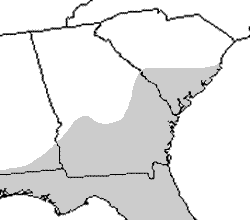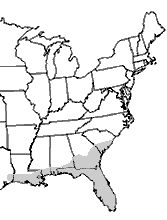Pig Frog (Rana [Lithobates] grylio)
![rangry210 Pig Frog (Rana [Lithobates] grylio)](https://srelherp.uga.edu/wp-content/uploads/sites/70/2024/01/rangry210.jpg)


Photos by J.D. Willson unless otherwise noted
Pig Frog’s Call
|
Description: Pig frogs are large frogs, ranging in size from 3.35 to 6.5 in (8.3-6.2 cm). Typically they are grayish-green or brown in coloration with black mottling on the dorsal surface. Pig frogs resemble Green Frogs (Rana [Lithobates] clamitans) and Bullfrogs (Rana [L.] catesbeiana) but have no dorsolateral folds and the extensive webbing between the toes, reaching the ends of each toe. The belly is light in color and may have dark spots. There may also be a line or row of spots on the back legs. Male pig frogs have a tympanum that is much larger than the eye, while the females have an equivalently sized eye and tympanum. Range and Habitat: Pig frogs are found throughout Florida and in the Coastal Plain of southern Georgia and southeastern South Carolina. They inhabit permanent bodies of water throughout their range. Open water areas of ponds and marshes are ideal pig frog habitat. Habits: Although generally highly aquatic, Pig Frogs may be found moving about on land at night or in wet weather. They breed from late Spring – August and exhibit external fertilization. Up to 10,000 eggs may constitute an egg mass. Eggs hatch in only a few days, but tadpoles may not metamorphose until a year of age. Call: The call of the Pig Frog is a low grunting sound, giving the frog its common name. Conservation Status: Throughout parts of their geographic range, pig frogs are considered species of concern. In Georgia, pig frogs are considered locally abundant and are unprotected species. Pertinent Reference: Account Author: Andy Howington, University of Georgia – edited by J.D. Willson, Katrina Ford, Lauren Maynor |
